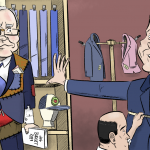COVID-19 has ended the immigration boom. In Australia, the tide of overseas workers and students that has contributed to 25 years of economic growth has stopped.
The mass movement of human populations that was part of the globalisation experiment has ended everywhere – at least for now. How will this sudden reversal change our society and the world?
Human geographer Alan Gamlen makes some tentative predictions, with the caveat that fortune-telling is always a risky business.
The 2008 Global Financial Crisis signalled the beginning of the end of mass migration, he says. Even Australia, which escaped the GFC relatively unscathed, has been debating whether the benefits of migration outweigh the costs.
Now, the global economy has been dealt a more savage blow, with demand collapsing in multiple sectors, from hospitality to aviation, and unemployment soaring.
Australian retailers have seen a 45 per cent drop in demand; in New Zealand it’s been 91 per cent. In the week of 15-21 March alone, 5.6 million Americans filed for unemployment, exceeding the unemployment caused by the GFC by nine or tenfold.
What are the long-term effects likely to be?
Demand for immigrant labour will fall
“It is difficult to overstate the scale of the crisis,” Dr Gamlen says. “With corporate borrowing at an historic high, many firms lack the revenue to service debt, and will cut staff numbers or fail altogether.”
He predicts that for those firms that do survive, “an unprecedentedly large recruitment pool of native workers” will be ready and waiting. There will be less need for immigrants to fill some gaps, and more political pressure to give native workers preference for others.
Anti-immigrant sentiment will rise
But what about the thousands of immigrants who find themselves stranded in foreign labour markets? “They are over-represented at both the high and low-skilled ends, where the ‘essential’ jobs cluster,” Dr Gamlen says.
“For example, the healthcare sectors of developed countries are particularly dependent on immigrant workers. If middle-class native employment suddenly drops, and immigrant employment seems to suddenly rise, there’s the potential for a perfect storm in public attitudes to immigrants, of the kind that can quickly turn quite nasty.”
The COVID-19 panic has already seen an ugly rise in anti-Chinese sentiment in Australia. When economic conditions worsen, outsiders can become scapegoats. Immigrants are resented if they work (for taking local jobs), and also for being unemployed (for not making a contribution).
“It’s reasonable to expect continuing growth in formal laws and regulations aimed at restricting international migration and mobility in the next few years.”
“Neither stereotype finds strong support in rigorous migration research,” Dr Gamlen says. “Unemployment rates among immigrants quickly settle to similar or lower levels than the rate among non-immigrants, and immigrants as a group typically contribute more in taxes than they consume in benefits, as well as driving demand by buying products and services,” he says.
“Meanwhile, the effect of immigration on native wages and unemployment, if any, is vanishingly small, because immigrants tend to do different jobs, often the essential but unglamorous ones that native workers won’t do.”
The anti-globalisation agenda will gain momentum
In rich countries before the pandemic, it was medium-skilled native workers, those who were once employed in manufacturing, for example, who were worst-affected by globalisation. Populist, anti-immigration politicians directed their pitch to this group.
While it “might be true” that a factory worker in a developed country has lost their job “because of increased manufacturing in China and growing global trade, that’s hard to distil into a campaign slogan”, Dr Gamlen says. “It’s much easier to simplify and project the problems of globalisation on to people who look and sound different – and this is precisely what we’ve seen happening since the 2008 crash.”
COVID-19 “may become a test of what is possible with regard to shutting down globalisation”, Dr Gamlen predicts. Politicians with this agenda “will find many silver linings in the lockdown” to bolster their program, which includes rolling back international trade and finance as well as migration, he predicts.
“Against this background, it’s reasonable to expect continuing growth in formal laws and regulations aimed at restricting international migration and mobility in the next few years,” he says.

Would-be migrants will choose to stay home
COVID-19 might also influence whether migrants themselves are willing to risk leaving their country of origin in the first place. Research into the consequences of the 2019 Albanian earthquake shows that the unforeseen disaster influenced the local population’s tolerance of risk, and made them less patient.
“Under normal conditions, patience is a deliberate technique for controlling risk,” Dr Gamlen explains. “Investors know that they have to hold risky assets for longer in order to make a profit. Similarly, migrants calculate that moving might set them back for several years in social and career terms before they start seeing the benefits.”
The pandemic “may have a particularly large dampening effect on risky behaviour that might only pay off in the long term,” he says, “and we may see a tapering off on the supply of international migrants wanting to move”.
City office space will stay empty
Finally, the shutdown may provide office managers with evidence that their workforce can remain productive if they stay at home. Potentially, this could result in “counter-urbanisation, as workplaces cut the costs of office space”.
This article was published by Lens.















